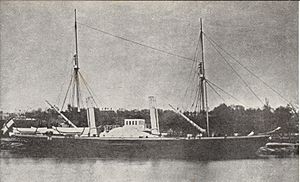HMS Porcupine (1844) facts for kids

HMS Porcupine
|
|
Quick facts for kids History |
|
|---|---|
| Name | HMS Porcupine |
| Ordered | 11 November 1843 |
| Builder | Deptford Dockyard |
| Cost | Hull £7,997, fitting out £7,050 |
| Launched | 17 June 1844 |
| Commissioned | 19 August 1844 |
| Fate |
|
| General characteristics | |
| Class and type | Steam vessel, re-classified in 1844 as first-class steam gunvessel |
| Displacement | 490 tons |
| Tons burthen | 381 68/94 bm |
| Length |
|
| Beam | 24 ft 1.5 in (7.353 m) |
| Depth of hold | 13 ft (4.0 m) |
| Installed power |
|
| Propulsion |
|
| Crew | 80 |
| Armament |
|
HMS Porcupine was a special ship in the Royal Navy. It was a wooden paddle steamer with three guns. Built in 1844, its main job was to explore and map the seas. It started by surveying the Thames Estuary in England.
Contents
Exploring the Seas: HMS Porcupine's Journey
HMS Porcupine was a very important ship for scientific exploration. It helped us learn more about the ocean floor.
Early Missions of the Porcupine
In 1847, Porcupine helped with a big problem: a famine in Ireland and western Scotland. It delivered important supplies to people who needed them. After that, the ship sailed in the Mediterranean Sea. It returned to England in 1851.
During the Crimean War, Captain Henry Charles Otter commanded the Porcupine. After the war, it went back to surveying. In 1858, the ship crossed the Atlantic Ocean. It helped with the huge project of laying the very first transatlantic telegraph cable. This cable allowed messages to be sent across the ocean!
Mapping the Ocean Floor
In 1862, Porcupine was busy mapping the sea off the west coast of Ireland. This was to prepare for a new transatlantic telegraph cable. Earlier maps showed very steep drops at the edge of the continental shelf. But the Porcupine's work found a better, flatter path.
Discovering New Life
During this mapping trip, the ship also collected samples from the seabed. Some samples came from very deep, about 1,240 fathoms (which is over 2,200 meters!). One sample contained a shell from a new type of brachiopod, a sea creature. These samples also showed how sedimentary rock forms on the ocean floor.

Deep Sea Discoveries
From 1863, Captain Edward Killwick Calver commanded the Porcupine. He was in charge of mapping the east coast of England.
Disproving the Azoic Theory
In 1869, a group called the Royal Society rented the Porcupine. They wanted to explore the deep seabed west of Ireland. They were looking for living creatures below 600 meters (about 2,000 feet). At that time, a scientist named Edward Forbes had a theory called the "azoic theory." He thought that no life could exist below 600 meters because of the huge pressure.
The Porcupine expedition proved him wrong! They found animals living at depths of 3,000 meters (almost 10,000 feet). This amazing discovery showed that life could thrive in the deepest parts of the ocean.
The Challenger Expedition
Because of the Porcupine's findings, more money was given for deep-sea exploration. This led to the famous Challenger expedition. The Challenger traveled around the world to survey the deep sea.
The Porcupine Bank, an area of the seabed west of Ireland, was discovered during these expeditions. It is named after this very important ship.

